Candidates can download NCERT Exemplar Class 11 Chemistry Chapter 8 from this page. The exemplar has been provided by the National Council of Educational Research & Training (NCERT) and the candidates can check it from below for free of cost. It contains objective, very short answer type, short answer type, and long answer type questions. Along with it, the answer for each question has also been provided. From the NCERT Exemplar Class 11 Chemistry Chapter 8, candidates can understand the level and type of questions that are asked in the exam.
NCERT Exemplar Class 11 Chemistry Unit 8 Redox Reactions
NCERT Class 11 Chemistry Chapter 8 is for Redox Reactions. The type of questions that will be asked from NCERT Class 11 Chemistry Chapter 8 are displayed in the below provided NCERT Exemplar Class 11 Chemistry Chapter 8. With the help of it, candidates can prepare well for the examination.
Also Check: NCERT Solutions for Class 11 Chemistry
Multiple Choice Questions (Type-I)
- Which of the following is not an example of redox reaction?
(i) CuO + H2 ⎯→ Cu + H2O
(ii) Fe2O3 + 3CO ⎯→ 2Fe + 3CO2
(iii) 2K + F2 ⎯→ 2KF
(iv) BaCl2 + H2SO4 ⎯→ BaSO4 + 2HCl - The more positive the value of E⊖ , the greater is the tendency of the species to get reduced. Using the standard electrode potential of redox couples given below find out which of the following is the strongest oxidising agent.

(i) Fe3+
(ii) I2 (s)
(iii) Cu2+
(iv) Ag+ - E⊖ values of some redox couples are given below. On the basis of these values choose the correct option.

(i) Cu will reduce Br–
(ii) Cu will reduce Ag
(iii) Cu will reduce I–
(iv) Cu will reduce Br2 - Using the standard electrode potential, find out the pair between which redox reaction is not feasible.

i) Fe3+ and I–
(ii) Ag+ and Cu
(iii) Fe3+
(iv) Ag and Fe3+ - Thiosulphate reacts differently with iodine and bromine in the reactions given below:

Which of the following statements justifies the above dual behaviour of thiosulphate?
(i) Bromine is a stronger oxidant than iodine.
(ii) Bromine is a weaker oxidant than iodine.
(iii) Thiosulphate undergoes oxidation by bromine and reduction by iodine in these reactions.
(iv) Bromine undergoes oxidation and iodine undergoes reduction in these reactions. - The oxidation number of an element in a compound is evaluated on the basis of certain rules. Which of the following rules is not correct in this respect?
(i) The oxidation number of hydrogen is always +1.
(ii) The algebraic sum of all the oxidation numbers in a compound is zero.
(iii) An element in the free or the uncombined state bears oxidation number zero.
(iv) In all its compounds, the oxidation number of fluorine is – 1. - In which of the following compounds, an element exhibits two different oxidation states.
(i) NH2OH
(ii) NH4NO3
(iii) N2H4
(iv) N3H - Which of the following arrangements represent increasing oxidation number of the central atom?

- The largest oxidation number exhibited by an element depends on its outer electronic configuration. With which of the following outer electronic configurations the element will exhibit largest oxidation number?
(i) 3d1 4s2
(ii) 3d3 4s2
(iii) 3d5 4s1
(iv) 3d5 4s2 - Identify disproportionation reaction
(i) CH4 + 2O2 → CO2 + 2H2O
(ii) CH4 + 4Cl2→ CCl4 + 4HCl
(iii) 2F2 + 2OH– → 2F – + OF2 + H2O
(iv) 2NO2 + 2OH– ⎯→ NO2– + NO3– + H2O - Which of the following elements does not show disproportionation tendency?
(i) Cl
(ii) Br
(iii) F
(iv) I
Multiple Choice Questions (Type-II)
In the following questions two or more options may be correct.
- Which of the following statement(s) is/are not true about the following decomposition reaction.
2KClO3 → 2KCl + 3O2
(i) Potassium is undergoing oxidation
(ii) Chlorine is undergoing oxidation
(iii) Oxygen is reduced
(iv) None of the species are undergoing oxidation or reduction - Identify the correct statement (s) in relation to the following reaction:
Zn + 2HCl → ZnCl2 + H2
(i) Zinc is acting as an oxidant
(ii) Chlorine is acting as a reductant
(iii) Hydrogen ion is acting as an oxidant
(iv) Zinc is acting as a reductant - The exhibition of various oxidation states by an element is also related to the outer orbital electronic configuration of its atom. Atom(s) having which of the following outermost electronic configurations will exhibit more than one oxidation state in its compounds.
(i) 3s1
(ii) 3d14s2
(iii) 3d24s2
(iv) 3s2 3p3 - Identify the correct statements with reference to the given reaction
P4 + 3OH– + 3H2O → PH3 + 3H2PO2–
(i) Phosphorus is undergoing reduction only.
(ii) Phosphorus is undergoing oxidation only.
(iii) Phosphorus is undergoing oxidation as well as reduction.
(iv) Hydrogen is undergoing neither oxidation nor reduction. - Which of the following electrodes will act as anodes, when connected to Standard Hydrogen Electrode?
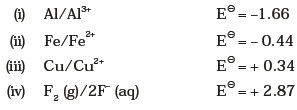
Short Answer Type Questions
- The reaction
Cl2 (g) + 2OH– (aq) ⎯→ ClO– (aq) + Cl– (aq) + H2O(l)
represents the process of bleaching. Identify and name the species that bleaches the substances due to its oxidising action. - MnO42– undergoes disproportionation reaction in acidic medium but MnO4– does not. Give reason.
- PbO and PbO2 react with HCl according to following chemical equations :
2PbO + 4HCl ⎯→ 2PbCl2 + 2H2O
PbO2 + 4HCl ⎯→ PbCl2 + Cl2 + 2H2O
Why do these compounds differ in their reactivity? - Nitric acid is an oxidising agent and reacts with PbO but it does not react with PbO2. Explain why?
- Write balanced chemical equation for the following reactions:
(i) Permanganate ion (MnO4–) reacts with sulphur dioxide gas in acidic medium to produce Mn2+ and hydrogensulphate ion.
(Balance by ion electron method)
(ii) Reaction of liquid hydrazine (N2H4) with chlorate ion (ClO3–) in basic medium produces nitric oxide gas and chloride ion in gaseous state.
(Balance by oxidation number method)
(iii) Dichlorine heptaoxide (Cl2O7) in gaseous state combines with an aqueous solution of hydrogen peroxide in acidic medium to give chlorite ion (ClO2–) and oxygen gas.
(Balance by ion electron method) - Calculate the oxidation number of phosphorus in the following species.
(a) HPO32- and
(b) PO43- - Calculate the oxidation number of each sulphur atom in the following compounds:
(a) Na2S2O3
(b) Na2S4O6
(c) Na2SO3
(d) Na2SO4 - Balance the following equations by the oxidation number method.
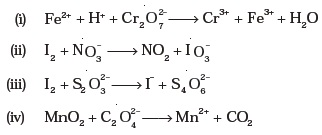
- Identify the redox reactions out of the following reactions and identify the oxidising and reducing agents in them.

- Balance the following ionic equations
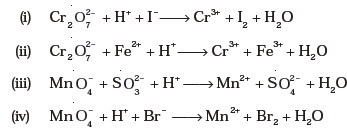
Matching Type Questions
- Match Column I with Column II for the oxidation states of the central atoms.

- Match the items in Column I with relevant items in Column II.
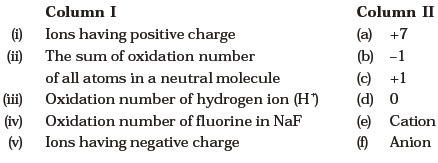
Assertion and Reason Type Questions
In the following questions a statement of assertion (A) followed by a statement of reason (R) is given. Choose the correct option out of the choices given below each question.
- Assertion (A) : Among halogens fluorine is the best oxidant.
Reason (R) : Fluorine is the most electronegative atom.
(i) Both A and R are true and R is the correct explanation of A.
(ii) Both A and R are true but R is not the correct explanation of A.
(iii) A is true but R is false.
(iv) Both A and R are false. - Assertion (A): In the reaction between potassium permanganate and potassium iodide, permanganate ions act as oxidising agent.
Reason (R) : Oxidation state of manganese changes from +2 to +7 during the reaction.
(i) Both A and R are true and R is the correct explanation of A.
(ii) Both A and R are true but R is not the correct explanation of A.
(iii) A is true but R is false.
(iv) Both A and R are false. - Assertion (A) : The decomposition of hydrogen peroxide to form water and oxygen is an example of disproportionation reaction.
Reason (R) : The oxygen of peroxide is in –1 oxidation state and it is converted to zero oxidation state in O2 and –2 oxidation state in H2O.
(i) Both A and R are true and R is the correct explanation of A.
(ii) Both A and R are true but R is not the correct explanation of A.
(iii) A is true but R is false.
(iv) Both A and R are false. - Assertion (A) : Redox couple is the combination of oxidised and reduced form of a substance involved in an oxidation or reduction half cell.

(i) Both A and R are true and R is the correct explanation of A.
(ii) Both A and R are true but R is not the correct explanation of A.
(iii) A is true but R is false.
(iv) Both A and R are false.
Long Answer Type Questions
- Explain redox reactions on the basis of electron transfer. Give suitable examples.
- On the basis of standard electrode potential values, suggest which of the following reactions would take place? (Consult the book for E⊖ value).
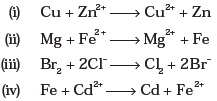
- Why does fluorine not show disporportionation reaction?
- Write redox couples involved in the reactions (i) to (iv) given in question 34.
- Find out the oxidation number of chlorine in the following compounds and arrange them in increasing order of oxidation number of chlorine.
NaClO4, NaClO3, NaClO, KClO2, Cl2O7, ClO3, Cl2O, NaCl, Cl2, ClO2.
Which oxidation state is not present in any of the above compounds? - Which method can be used to find out strength of reductant/oxidant in a solution? Explain with an example.
Click here to download the NCERT Exemplar Class 11 Chemistry Unit 8 Redox Reactions.
Answers to Multiple Choice Questions







Multiple Choice Questions (Type-I)
Multiple Choice Questions (Type-II)
Short Answer Type
Matching Type
Assertion and Reason Type
Chemistry Physics Maths Biology
To get study material, exam alerts and news, join our Whatsapp Channel.

